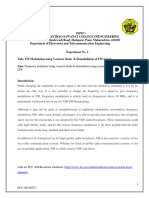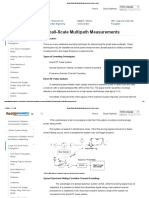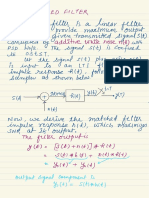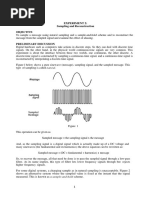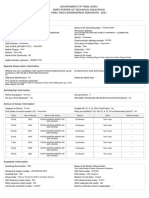100%(1)100% found this document useful (1 vote)
438 viewsModulation & Need For Modulation
This document provides an overview of modulation and the need for modulation in communication systems. It defines modulation as a process of changing one or more properties of an analog carrier signal in proportion to an information signal. The properties that can be changed include amplitude, frequency, and phase. Modulation is needed to radiate low frequency signals, reduce antenna height, increase communication range, improve reception quality, and allow multiplexing to reduce noise and interference. Multiplexing using modulation and different carrier frequencies allows different message signals to be transmitted simultaneously over the same channel.
Uploaded by
ragulCopyright
© © All Rights Reserved
Available Formats
Download as PPTX, PDF, TXT or read online on Scribd
100%(1)100% found this document useful (1 vote)
438 viewsModulation & Need For Modulation
This document provides an overview of modulation and the need for modulation in communication systems. It defines modulation as a process of changing one or more properties of an analog carrier signal in proportion to an information signal. The properties that can be changed include amplitude, frequency, and phase. Modulation is needed to radiate low frequency signals, reduce antenna height, increase communication range, improve reception quality, and allow multiplexing to reduce noise and interference. Multiplexing using modulation and different carrier frequencies allows different message signals to be transmitted simultaneously over the same channel.
Uploaded by
ragulCopyright
© © All Rights Reserved
Available Formats
Download as PPTX, PDF, TXT or read online on Scribd
You are on page 1/ 7
U18ECT3011 – Principles of Communication
1. Modulation
2. Need for Modulation
Ms.V.Uma Maheswari / AP I / ECE
Department of Electronics and Communication Engineering
Overview of this
Lecture
• Modulation
• Need for modulation and
Multiplexing
Modulation
What is modulation?
• A process of changing one or more properties of the
analog carrier in proportion to the information signal.
• One of the characteristics of the carrier signal is
changed according to the variations of the modulating
signal.
AM – amplitude, E
FM – frequency , ω
PM - phase , θ
Modulation -Explanation
Information bearing signal
Message signal
Modulating signal
Need for modulation
• Radiate Low frequency Signals
• Reduction in Antenna Height
• Increases the Range of Communication
• Improves the quality of reception
• Multiplexing
• To reduce noise and interferences
Multiplexing
CHANNEL
• Modulation helps in transmitting different message signals using
different carrier frequencies simultaneously over a same channel.
This kind of multiplexing is called Frequency Division
Multiplexing (FDM). FDM further reduces noise and interference.
You might also like
- Hourglass Workout Program by Luisagiuliet 276% (21)Hourglass Workout Program by Luisagiuliet 251 pages
- The Hold Me Tight Workbook - Dr. Sue Johnson100% (16)The Hold Me Tight Workbook - Dr. Sue Johnson187 pages
- Read People Like A Book by Patrick King-Edited62% (66)Read People Like A Book by Patrick King-Edited12 pages
- Livingood, Blake - Livingood Daily Your 21-Day Guide To Experience Real Health77% (13)Livingood, Blake - Livingood Daily Your 21-Day Guide To Experience Real Health260 pages
- COSMIC CONSCIOUSNESS OF HUMANITY - PROBLEMS OF NEW COSMOGONY (V.P.Kaznacheev,. Л. V. Trofimov.)94% (212)COSMIC CONSCIOUSNESS OF HUMANITY - PROBLEMS OF NEW COSMOGONY (V.P.Kaznacheev,. Л. V. Trofimov.)212 pages
- Donald Trump & Jeffrey Epstein Rape Lawsuit and Affidavits83% (1016)Donald Trump & Jeffrey Epstein Rape Lawsuit and Affidavits13 pages
- The 36 Questions That Lead To Love - The New York Times94% (34)The 36 Questions That Lead To Love - The New York Times3 pages
- The 36 Questions That Lead To Love - The New York Times95% (21)The 36 Questions That Lead To Love - The New York Times3 pages
- Jeffrey Epstein39s Little Black Book Unredacted PDF75% (12)Jeffrey Epstein39s Little Black Book Unredacted PDF95 pages
- The 4 Hour Workweek, Expanded and Updated by Timothy Ferriss - Excerpt23% (954)The 4 Hour Workweek, Expanded and Updated by Timothy Ferriss - Excerpt38 pages
- Communications Lab Manual Amplitude Modulation and DSB-SC75% (4)Communications Lab Manual Amplitude Modulation and DSB-SC85 pages
- Experiment No 2 FM Generation Using Varactor Diode MethodNo ratings yetExperiment No 2 FM Generation Using Varactor Diode Method5 pages
- Small-Scale Multipath Measurements Lecture NotesNo ratings yetSmall-Scale Multipath Measurements Lecture Notes6 pages
- Sampling Theorem Verification: Electronics & Communication Engineering100% (1)Sampling Theorem Verification: Electronics & Communication Engineering0 pages
- Principles of Electronic Communication Systems: Second Edition Louis FrenzelNo ratings yetPrinciples of Electronic Communication Systems: Second Edition Louis Frenzel41 pages
- ANALOG COMMUNICATION LAB Questions and AnswersNo ratings yetANALOG COMMUNICATION LAB Questions and Answers10 pages
- Chapter 2 - Part 1-Amplitude Modulation - v2100% (2)Chapter 2 - Part 1-Amplitude Modulation - v250 pages
- School of Electronics Engineering (Sense)No ratings yetSchool of Electronics Engineering (Sense)12 pages
- Micro-Controller and Interfacing Exam PaperNo ratings yetMicro-Controller and Interfacing Exam Paper2 pages
- Experiment No. 03 Experiment Name-PSK Modulation AIM Equipments RequiredNo ratings yetExperiment No. 03 Experiment Name-PSK Modulation AIM Equipments Required8 pages
- Chapter One: Review of Digital Communication SystemsNo ratings yetChapter One: Review of Digital Communication Systems26 pages
- Pulse Amplitude Modulation (PAM) - Working, Types & Its Applications100% (1)Pulse Amplitude Modulation (PAM) - Working, Types & Its Applications15 pages
- Experiment 2: Sampling and Reconstruction Objective100% (1)Experiment 2: Sampling and Reconstruction Objective8 pages
- Optical Communication Past Questions and SolutionsNo ratings yetOptical Communication Past Questions and Solutions25 pages
- 1.classification of Amplifiers, Distortions in AmplifiersNo ratings yet1.classification of Amplifiers, Distortions in Amplifiers12 pages
- Small Signal Analysis of Amplifiers (BJT & Fet) : Narayana Engineering College:: Nellore100% (1)Small Signal Analysis of Amplifiers (BJT & Fet) : Narayana Engineering College:: Nellore12 pages
- Double Side Band - Suppressed Carrier (DSB-SC) AND Single Side Band100% (1)Double Side Band - Suppressed Carrier (DSB-SC) AND Single Side Band55 pages
- Chapter 1 Overview of Wireless Communication Systems100% (1)Chapter 1 Overview of Wireless Communication Systems35 pages
- 1 Basics and Block Diagram of Digital CommunicationNo ratings yet1 Basics and Block Diagram of Digital Communication54 pages
- MANUAL COMMUNICATION LAB-II, KEC-651,2020-21, Even SemNo ratings yetMANUAL COMMUNICATION LAB-II, KEC-651,2020-21, Even Sem18 pages
- Module 1 - Introduction To Communications SystemsNo ratings yetModule 1 - Introduction To Communications Systems6 pages
- Chapter 1: Introduction To Communication Systems: Multiple ChoiceNo ratings yetChapter 1: Introduction To Communication Systems: Multiple Choice11 pages
- Microwave Phase Shifters and AttenuatorsNo ratings yetMicrowave Phase Shifters and Attenuators3 pages
- Ec6651 Communication Engineering Unit 1No ratings yetEc6651 Communication Engineering Unit 173 pages
- 10th Marksheet Compressed For Counselling Website100% (1)10th Marksheet Compressed For Counselling Website2 pages
- Government of Tamil Nadu Directorate of Technical Education Tamil Nadu Engineering Admission - 2021No ratings yetGovernment of Tamil Nadu Directorate of Technical Education Tamil Nadu Engineering Admission - 20213 pages
- Livingood, Blake - Livingood Daily Your 21-Day Guide To Experience Real HealthLivingood, Blake - Livingood Daily Your 21-Day Guide To Experience Real Health
- COSMIC CONSCIOUSNESS OF HUMANITY - PROBLEMS OF NEW COSMOGONY (V.P.Kaznacheev,. Л. V. Trofimov.)COSMIC CONSCIOUSNESS OF HUMANITY - PROBLEMS OF NEW COSMOGONY (V.P.Kaznacheev,. Л. V. Trofimov.)
- Donald Trump & Jeffrey Epstein Rape Lawsuit and AffidavitsDonald Trump & Jeffrey Epstein Rape Lawsuit and Affidavits
- The 36 Questions That Lead To Love - The New York TimesThe 36 Questions That Lead To Love - The New York Times
- The 36 Questions That Lead To Love - The New York TimesThe 36 Questions That Lead To Love - The New York Times
- Jeffrey Epstein39s Little Black Book Unredacted PDFJeffrey Epstein39s Little Black Book Unredacted PDF
- The 4 Hour Workweek, Expanded and Updated by Timothy Ferriss - ExcerptThe 4 Hour Workweek, Expanded and Updated by Timothy Ferriss - Excerpt
- Communications Lab Manual Amplitude Modulation and DSB-SCCommunications Lab Manual Amplitude Modulation and DSB-SC
- Experiment No 2 FM Generation Using Varactor Diode MethodExperiment No 2 FM Generation Using Varactor Diode Method
- Sampling Theorem Verification: Electronics & Communication EngineeringSampling Theorem Verification: Electronics & Communication Engineering
- Principles of Electronic Communication Systems: Second Edition Louis FrenzelPrinciples of Electronic Communication Systems: Second Edition Louis Frenzel
- Experiment No. 03 Experiment Name-PSK Modulation AIM Equipments RequiredExperiment No. 03 Experiment Name-PSK Modulation AIM Equipments Required
- Chapter One: Review of Digital Communication SystemsChapter One: Review of Digital Communication Systems
- Pulse Amplitude Modulation (PAM) - Working, Types & Its ApplicationsPulse Amplitude Modulation (PAM) - Working, Types & Its Applications
- Experiment 2: Sampling and Reconstruction ObjectiveExperiment 2: Sampling and Reconstruction Objective
- Optical Communication Past Questions and SolutionsOptical Communication Past Questions and Solutions
- 1.classification of Amplifiers, Distortions in Amplifiers1.classification of Amplifiers, Distortions in Amplifiers
- Small Signal Analysis of Amplifiers (BJT & Fet) : Narayana Engineering College:: NelloreSmall Signal Analysis of Amplifiers (BJT & Fet) : Narayana Engineering College:: Nellore
- Double Side Band - Suppressed Carrier (DSB-SC) AND Single Side BandDouble Side Band - Suppressed Carrier (DSB-SC) AND Single Side Band
- Chapter 1 Overview of Wireless Communication SystemsChapter 1 Overview of Wireless Communication Systems
- 1 Basics and Block Diagram of Digital Communication1 Basics and Block Diagram of Digital Communication
- MANUAL COMMUNICATION LAB-II, KEC-651,2020-21, Even SemMANUAL COMMUNICATION LAB-II, KEC-651,2020-21, Even Sem
- Chapter 1: Introduction To Communication Systems: Multiple ChoiceChapter 1: Introduction To Communication Systems: Multiple Choice
- Government of Tamil Nadu Directorate of Technical Education Tamil Nadu Engineering Admission - 2021Government of Tamil Nadu Directorate of Technical Education Tamil Nadu Engineering Admission - 2021






































